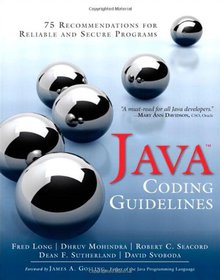Java Coding Guidelines
75 Recommendations for Reliable and Secure Programs

Book Details:
| Publisher: | Addison-Wesley Professional |
| Series: | Addison Wesley |
| Author: | Robert C. Seacord |
| Edition: | 1 |
| ISBN-10: | 032193315X |
| ISBN-13: | 9780321933157 |
| Pages: | 304 |
| Published: | Sep 09 2013 |
| Posted: | Nov 19 2014 |
| Language: | English |
| Book format: | |
| Book size: | 2.04 MB |
Book Description:
'A must-read for all Java developers. . . . Every developer has a responsibility to author code that is free of significant security vulnerabilities. This book provides realistic guidance to help Java developers implement desired functionality with security, reliability, and maintainability goals in mind.' Mary Ann Davidson, Chief Security Officer, Oracle Corporation Organizations worldwide rely on Java code to perform mission-critical tasks, and therefore that code must be reliable, robust, fast, maintainable, and secure. Java Coding Guidelines brings together expert guidelines, recommendations, and code examples to help you meet these demands. Written by the same team that brought you The CERT Oracle Secure Coding Standard for Java, this guide extends that previous work's expert security advice to address many additional quality attributes. You'll find 75 guidelines, each presented consistently and intuitively. For each guideline, conformance requirements are specified; for most, noncompliant code examples and compliant solutions are also offered. The authors explain when to apply each guideline and provide references to even more detailed information. Reflecting pioneering research on Java security, Java Coding Guidelines offers updated techniques for protecting against both deliberate attacks and other unexpected events. You'll find best practices for improving code reliability and clarity, and a full chapter exposing common misunderstandings that lead to suboptimal code. With a Foreword by James A. Gosling, Father of the Java Programming Language
Download Link:
Related Books:
C++ Coding Standards
101 Rules, Guidelines, and Best Practices
Consistent, high-quality coding standards improve software quality, reduce time-to-market, promote teamwork, eliminate time wasted on inconsequential matters, and simplify maintenance. Now, two of the world's most respected C++ experts distill the rich collective experience of the global C++ community into a set of coding standards that every developer and development team can understand and use as a basis for their own coding standards. The authors cover virtually every facet of C++ programming: design and coding style, functions, operators, class design, inheritance, construction/destruction, copying, assignment, namespaces, modules, templates, genericity, exceptions, STL containers and algorithms, and more. Each standard is described concisely, w...
Java Look and Feel Design Guidelines
2nd Edition
With Java Look and Feel Design Guidelines, Second Edition, Sun's Java Look & Feel group delivers powerful guidance for building cross-platform Java applications and applets that are consistent, attractive, and offer outstanding usability and productivity. This brand-new, 4-color Second Edition is fully updated for Java 1.3 Standard Edition (Java 2), and contains a new CD-ROM packed with code developers can use to incorporate the design standards quickly and easily. Heavily endorsed and promoted by Sun, the book starts with a visual tour of a Java application and applet utilizing the Java Look and Feel and built with Java Foundation Classes (JFC) co...
Java Look and Feel Design Guidelines
Advanced Topics
This book brings together advanced guidelines and techniques for building exceptionally effective user interfaces with Java technology. Building on the insights presented in Java Look and Feel Design Guidelines, Second Edition, this book focuses on several key opportunities to enhance Java user interfaces, and draws upon brand-new user analyses by Sun Microsystems' Java Look and Feel Design Group. The authors begin with in-depth coverage of Java windows, including techniques for choosing the right window type, designing window elements, setting state, and handling multiple windows. In a detailed chapter on menus, they show how to design menu elements, common, and contextual menus; and assign mnemonics and keyboard shortcuts. The book demonstrates how...
2007 - 2021 © eBooks-IT.org



